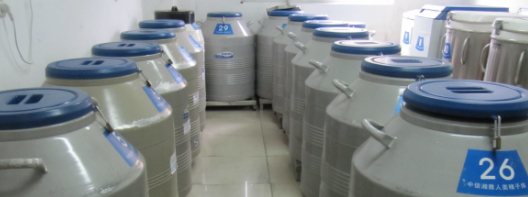China needs babies
Anthropological study shows a Chinese fertility industry on the rise.

The CITIC-Xiangya Reproductive and Genetic Hospital carries out more than 40,000 treatments annually.
Infertile Chinese couples sometimes spend the night on sidewalks in front of fertility clinics so that they can stay in line. Often they have waited two to three years before accessing expensive fertility treatments.
- You almost have to squeeze your way into a fertility clinic, and
at the same time sperm banks are in chronic states of emergency. Some even dubbed it a fertility crisis in China, says Ayo Wahlberg, a professor at the Department of Anthropology, Faculty of the Social Sciences, University of Copenhagen.
Ayo Wahlberg has done seven years of research in the Chinese fertility industry, which has just been published in the form of a book with the University of California Press. The research was carried out with the support of the Danish Council of Independent Research.
Why China lacks babies
In 2015, the government famously tweaked its one-child policy into its current two-child policy, which for the first time since the 1980s allows all married couples to have two children, if they so wish.

Like in Europe, an estimated 10 percent of Chinese couples experience fertility issues. That’s a doubling when compared to the beginning of the 1990s (Photo:Ayo Wahlberg)
The problem is that, if early indications are anything to go by, it doesn’t seem that Chinese couples are interested.
- Much like elsewhere in the world, young people in China are deferring marriage and reproduction. The average age at first birth is approaching 30 in larger cities. Couples are instead concentrating on their education and careers, says Ayo Wahlberg.
Once Chinese couples do decide to have children, they quickly find out how exorbitantly expensive it is to have a child, as pregnancy, child birth, childcare, school and college costs stack up.
- Moreover, many grew up as singletons themselves, and they are used to small families. In short, China has become what demographers refer to as a low fertility culture, says Ayo Wahlberg.
Fertility issues
Like in Europe, an estimated 10 percent of Chinese couples experience fertility issues. That’s a doubling when compared to the beginning of the 1990s. Today, China’s fertility industry simply cannot keep up with growing demand from infertile couples.
Ayo Wahlberg investigated how assisted reproductive technologies have become one of the most important family planning means in a country that has otherwise had three decades of a strict one-child policy.
- Assisted reproductive technologies and the clinics that provide them gained acceptance by adhering to family planning policies. For example, clinics require that couples arrive with the proper paperwork from their local family planning offices, he explains.
As increasing numbers of Chinese people are deciding to reproduce later in their lives, fewer are capable of doing so without help from fertility clinics. Chinese fertility researchers also worry about the effects of pollution on fertility.
Speeding up the process
China’s – and the world’s - largest fertility clinic has been Ayo Wahlberg’s main research site for his seven-year anthropological study.
The CITIC-Xiangya Reproductive and Genetic Hospital carries out over 40,000 treatments annually.

Today, China’s fertility industry simply cannot keep up with growing demand from infertile couples (photo: Ayo Wahlberg).
- The clinic’s sperm bank has described how my anthropological research led them to refocus their attention from their protocols towards their donors and users. They’ve gone from screening 3000 to 6000 potential donors per year, says Ayo Wahlberg.
For example, the clinic has changed its donation times for donors to regular weekday opening hours instead of scheduled timeslots.
Nevertheless, Ayo Wahlberg doesn’t think China’s low fertility will be changing any time soon.
- They will have to change their fertility culture first, not to mention introduce social changes, so life becomes easier for young Chinese families, he says.
Contact
Ayo Wahlberg
Professor at the Department of Anthropology, University of Copenhagen.
Cell: +0045 60753078
Topics
Related News
Contact
Ayo Wahlberg
Professor at the Department of Anthropology, University of Copenhagen.
Mail:ayo.wahlberg@anthro.ku.dk
Cell: +0045 60 75 30 78
Maj Bach Madsen
Communications Officer
Mail:mbm@samf.ku.dk
Phone: +0045 35 32 63 50
Read more
More information on the book:'Good Quality – the Routinization of Sperm Banking in China’, which has just been published with University of California Press. The research was carried out with the support of the Danish Council of Independent Research.
